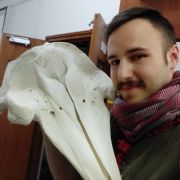Matteo Bormetti
MSc, MA, BA
Department of Archaeology
Research Student
Thesis- Animal husbandry in the British Later Iron Age: investigating economic and social change through zooarchaeology


Full contact details
Department of Archaeology
Minalloy House
10-16 Regent Street
Sheffield
S1 3NJ
- Qualifications
-
- 2018 – Present- PhD Candidate – Department of Archaeology, The University of Sheffield
- 2017- MSc Osteoarchaeology – University of Sheffield (Distinction)
- 2016- MA Archaeology – State University of Milan (110/110 e lode)
- 2012- BA Heritage Science – University of Milan (103/110)
- Research interests
-
Thesis- Animal husbandry in the British Later Iron Age: investigating economic and social change through zooarchaeology
- Supervisors- Professor Umberto Albarella & Dr Bob Johnston
My research primarily concerns the relationship between humans and other animals in the past. I have an interest in the archaeology of prehistoric and early historic Mediterranean, Northern Europe and the Arabian Peninsula. I have been working on the reconstruction of animal husbandry strategies, waste disposal practices, the exploitation of cetaceans species and ancient beekeeping
Thesis Abstract
The main aim of this PhD project is to evaluate to what extent the British Late Iron Age was ‘static’ or ‘dynamic’ in terms of its livestock type and management, and whether some of the husbandry innovations that we see in the Roman period had deeper roots in the Iron Age.
Zooarchaeological data will be interpreted with the intent to reconstruct the changes in the ways of life of late prehistoric farming communities, concentrating on the transition between Middle Iron Age and Late Iron Age in Central England.
This project will combine the study of faunal remains with that of their context of deposition: each site will be studied using a range of zooarchaeological analyses that includes livestock frequencies and ageing, spatial patterning of body parts, butchery, gnawing and burning marks within single sites and contexts, and the estimate of size and shape of the livestock through the analysis of bone measurements.
The key goals of this study are:
- to reconstruct waste disposal practices and assess how they influence the composition of the assemblages and the reliability of other analyses
- to investigate the diachronic change of animal husbandry and its relationship with social change; to define carcass processing and butchery in relation to economy
- to detect landraces and livestock improvement by comparing variations in size and shape; to compare all the above-mentioned results geographically with Southern England and diachronically to the Romanisation period.
- Grants
-
- 2018 – 2021- White Rose College of Arts and Humanities (WRoCAH) AHRC Studentship, UK
- Publications and Conferences
-
Publications
-
-
Bormetti, M. and Maini, E. (submitted). Zooarchaeological analysis of the faunal assemblage from the Iron Age site of Guardamonte (Italy). International Journal of Student Research in Archaeology.
-
Bormetti, M. 2014. Api e miele nel Mediterraneo antico. Acme 67(1), 7-50. [http://dx.doi.org.pros.lib.unimi.it/10.131390/22820035/3869] http://riviste.unimi.it/index.php/ACME/issue/view/583
-
-
Conferences
-
-
17th-21th October 2017. Poster presentation: Analisi Faunistiche nel sito dell’età del Ferro del Guardamonte (AL-PV). With Giorgio Baratti and Elena Maini. LII Riunione Scientifica Preistoria e Protostoria in Lombardia e Canton Ticino, Milano, Italy.
-
31th May – 3rd June 2017. Oral presentation: Zooarchaeological analysis of the faunal assemblage from the Iron Age site of Guardamonte (Italy). With Elena Maini. 20th Iron Age Student Research Symposium (IARSS), Bradford, UK.
-
23rd-25th March 2017. Poster presentation: Zooarchaeological analysis of the faunal assemblage from the Iron Age site of Guardamonte (Italy). With Elena Maini. VI Postgraduate Zooarchaeology Forum (PZAF), Toruń, Poland.
-
-
